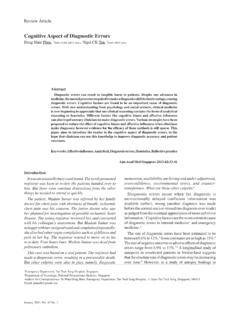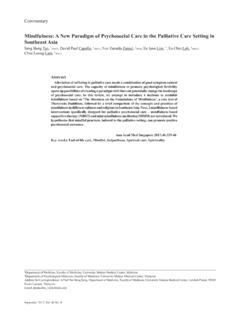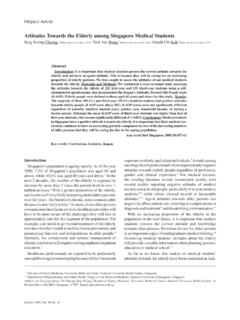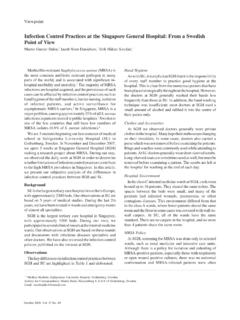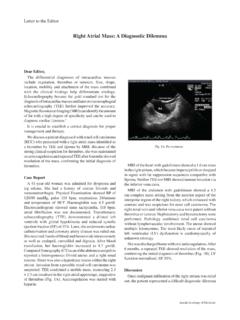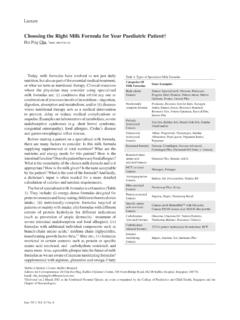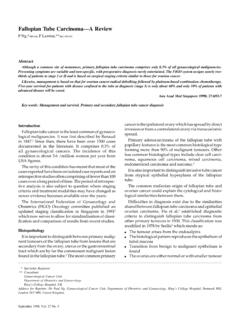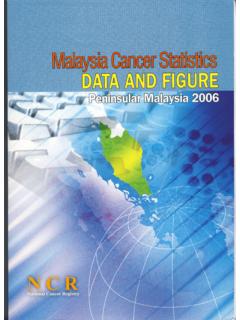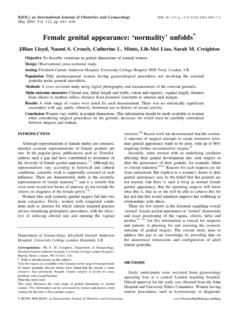Transcription of Endometrioid Adenocarcinoma of the Uterus: …
1 670 Annals Academy of MedicineEndometrioid Adenocarcinoma of the Uterus J J Chee et alEndometrioid Adenocarcinoma of the Uterus: Surgico-Pathological Correlationsand Role of Pelvic LymphadenectomyJ J Chee,*MBBS, MRCOG, T H Ho,**FAMS, M Med (O&G), FRCOG (Lond), E H Tay,**M Med (O&G), MRCOG (Lond), DGO,J J H Low,+FAMS, M Med (O&G), MRCOG (Lond), K L Yam,++FAMS, M Med (O&G), FRCOG (Lond)AbstractIntroduction: In 1988, FIGO added lymph node surgery to the staging system for endometrial cancer. This change remains controversialto date. From our study we aim to determine the significance of surgico-pathological parameters of Endometrioid carcinoma for pelvic nodalmetastases and survival, as well as to study the role of pelvic lymphadenectomy in the surgical treatment of this disease. Materials andMethods: A retrospective study was conducted in 198 women with Endometrioid carcinoma who underwent full surgical staging includingpelvic lymphadenectomy.
2 The multiple variant regression analysis and the multi-variant logistic regression analysis were applied in theanalysis of relationship. Results: A positive correlation between nodal metastases and grade, myometrial invasion, peritoneal cytology,adnexal involvement, lymphvascular space involvement and tumour size was found. For survival, significant prognosticators were grade,myometrial invasion, peritoneal cytology, lymphvascular space involvement, adnexal involvement, associated atypia and pelvic nodalmetastases. Thirty-five per cent of the patients had high risk of recurrence based on uterine pathological factors but were node were spared external beam radiation and its associated morbidities, and were treated with adjuvant vault brachytherapy instead. Sixper cent of the patients would have been understaged based on uterine factors alone if pelvic lymphadenectomy had not been : We infer that routine pelvic lymphadenectomy should be considered for all surgically fit patients with Endometrioid accurate staging will allow individualised adjuvant therapy and prevent understaging and Acad Med Singapore 2003; 32:670-5 Key words: Accurate staging, Individualised treatment, Morbidities, Nodal metastases, Pathological parametersIntroductionEndometrial cancer is the most common female genitalmalignancy in industralised countries today.
3 Despite theoverall favourable prognosis in this neoplasia, survival isassociated with several prognostic factors. In endometrialcancer, one of the most potent prognostic factors isnodal metastasis. Nodal metastasis, in turn, has beenfound to correlate with many histopathologic incorporated lymph node status into its stagingsystem of endometrial cancer in 1988. The addition ofroutine lymphadenectomy to total abdominal hysterectomybilateral salpingo-oopherectomy (TAHBSO) aims toprovide accurate staging of the disease, so that patients maybenefit from individualised postoperative adjuvant , the therapeutic benefit and morbidity oflymphadenectomy remain controversial. Morbidities of thepelvic lymph node dissection include lymphoedema,lymphocyst, deep vein thrombosis and life-threateningpulmonary embolism. The addition of approximately 30minutes of operating time, together with possible increasein intra- and postoperative complications must be offsetagainst the morbidity of pelvic irradiation.
4 The optimalmanagement of lymph nodes remains to be the Gynaecological Cancer Centre (GCC) in the KKWomen s and Children s Hospital (KKH), staging surgeryfor endometrial cancer has included TAHBSO, routinepelvic lymphadenectomy and peritoneal washings since1996. Prospective pelvic lymphadenectomy was donebecause of the following assumptions:* RegistrarDepartment of General Obstetrics & Gynaecology** Chief of GynaecologySenior Consultant and Clinical Associate Professor** Consultant and Head+ Consultant++ Senior ConsultantGynaecological Oncology UnitKK Women s & Children s HospitalAddress for Reprints: Dr J J Chee, Gynaecological Oncology Unit, KK Women s & Children s Hospital, 100 Bukit Timah Road, Singapore 2003, Vol. 32 No. 5671 Endometrioid Adenocarcinoma of the Uterus J J Chee et al1) Lymph node status is the most important prognosticatorin endometrial ) Lymphadenectomy in the surgical staging can beperformed quickly with minimal blood loss ) Performing lymphadenectomy on all patients allowstailoring of postoperative adjuvant therapy by replacingexternal beam radiation with vaginal cuff brachytherapyfor high-risk, early-stage node negative disease, andthereby avoiding the morbidity of external beamradiation on these selected group of 1998 our treatment protocol has been to dividestage 1 Endometrioid cancer into a low-risk group and ahigh-risk group.
5 The low-risk group comprises of Grade(G) 1 Stage 1a, 1b and G2 stage 1a; they are deemed to havelow risk of recurrence and hence do not receive anyadjuvant radiation. The rest of stage 1, , G1 Stage1c, G2 Stage 1b, c and G3 Stage 1a, b, c and Stage 2a are at higherrisk of recurrence and they receive vault brachytherapy asadjuvant therapy. External pelvic irradiation is omitted onthe basis of negative pelvic lymph objectives of this study were:1) to study the correlation of the various surgico-pathologicprognostic factors with pelvic lymph node metastasis inendometrioid carcinoma of the uterus,2) to determine the proportion of patients with high-riskearly stage disease who avoided external beam radiationas a result of pelvic lymphadenectomy,3) to study the role of pelvic lymphadenectomy in thesurgical staging of Endometrioid cancer of the uterusand the proportion of cases whose stage has beenaltered as a result of lymph node involvement,4) to determine the association of the pathologiccharacteristics of pelvic lymph node involvement withdisease recurrence and survival, and5)
6 To determine the long-term survival and late complicationof high-risk early stage disease treated with pelviclymphadenectomy and brachytherapy without externalbeam and MethodsThis is a retrospective review of 223 patients who werediagnosed to have Endometrioid carcinoma over the 4 -year period from January 1996 to June 2000. Of these, 198underwent TAHBSO and pelvic lymphadenectomy andthus were eligible for our study. Patients with high-risk celltypes, , clear cell, serous carcinoma and undifferentiated,were omitted from the study. Data were obtained from caserecords and the GCC Tumour patients were operated on by gynaecologicaloncologists. Pelvic lymph nodes were removed in front of,behind, and between the iliac vessels up to the bifurcationof the aorta and down to the obturator fossa and the pelvicfloor. All histopathology specimens were reviewed by thecentre s gynaecological pathologist. All cases weremanaged at the centre in a multi-disciplinary surveillance consisted of history, physicalexamination and vault smear every 3 months for the firstyear, every 4 months for the second year, and every 6months for the third year through fifth year, and every yearfrom then evaluate lymph node metastases, multiple variantregression analyses were carried out for 9 clinico-pathological factors including tumour grade, myometrialinvasion, peritoneal cytology, site of tumour, adnexalinvolvement, cervical involvement, associated hyperplasia,lymphvascular space involvement and size of tumour.
7 Inaddition, the multi-variant logistic regression test wasapplied in the analysis of relationship between thesepathological factors and the prediction of age of the 198 patients ranged from 30 to 83 years(median 54 years). Majority (55%) were post menopausaland 45% were surgical staging included 139 ( ) patients withstage 1, 27 ( ) with stage 2, 31 ( ) with stage 3 and1 ( ) with stage 4 disease (Table I). The number oflymph nodes removed ranged from 1 to 49 (mean 20).Seventeen (9%) of the 198 women had positive lymphnodes (Table I). Disease characteristics of these womenincluded greater than 50% myometrial invasion in 13patients, grade 3 tumour in 7, lymphvascular spaceinvolvement in 15, cervical involvement in 2 and adnexalinvolvement in 5 patients. A review of these 17 patientswith nodal disease showed 11 women would be understagedif pelvic lymphadenectomy had not been done. One will beclinical stage 1a, 2 will be stage 1b and 8 will be stage other words, if pelvic lymphadenectomy had not beendone, 2% (1/57) of stage 1a, 4% (2/57) of stage 1b and 22%(8/36) of stage 1c will be understaged and as a , of the 181 patients with negative nodalstatus, 70 were considered to belong to high-risk, early-stage node negative disease (Table II).
8 This group ofpatients are in the high-risk group for recurrence, and theywould have been subjected to external beam radiation if thenodal status had not been known. Hence, 35% (70/198) ofpatients in this study were spared the effects of externalbeam radiation and its concomitant , grade 1 tumour in a clinically stage 1disease is assumed as low risk, and would have renderedlymphadenectomy unnecessary. In our series, however,out of 80 patients who belong to this category, 8 (10%)672 Annals Academy of MedicineEndometrioid Adenocarcinoma of the Uterus J J Chee et alactually had more than 50% myometrial invasion onhistology (Table III). The grade, size, myometrial invasion,peritoneal cytology, adnexal involvement andlymphvascular space involvement were significantlycorrelated with pelvic lymph node metastasis. On the otherhand, site of tumour, cervical involvement and endometrialhyperplasia showed no correlation to pelvic lymph nodemetastasis (Table IV).
9 Six patients had defaulted and were lost to follow-up. Ofthe remaining 192 patients, 9 had died, leaving 183 hundred seventy-three were well and alive with noevidence of disease, while the remaining 10 had documentedevidence of recurrence. Five died of Endometrioid carcinomaand 4 died of intercurrent disease. Of the 5 who died of thedisease, 2 were considered to be high-risk, early the 10 of the patients with recurrences, the recurrencewas only local in 2, distant in 5 and 3 women had both localand distant metastasis. Looking at the high-risk, early-stage node-negative group of patients, only 2 out of 70 hadrecurrences, 1 had distant recurrence whilst the other hadboth local and multi-variant logistic regression analysis, thevarious factors are correlated with prediction of of peritoneal cytology and adnexal involvementwere found to be significant. The odds ratio was forperitoneal cytology (CI ) (P = ), and foradnexal involvement (CI ) (P = ).
10 Using the Kaplan-Meier analysis, the mean length offollow-up was months (confidence range ). Of the 9 cases of death, the mean survival was The surgico-pathological factors that wereTABLE III: CORRELATION BETWEEN HISTOLOGIC GRADE ANDDEPTH OF INVASION IN STAGE 1 OF THE DISEASEG rade 1 Grade 2 Grade 3No invasion46(58%)6 (15%)4 (20%)Less than half26 (33%)18 (46%)11 (55%)More than half8 (10%)15 (39%)5 (25%)Total80(100%)39 (100%)20 (100%)TABLE II: DISTRIBUTION OF HIGH-RISK, EARLY-STAGE NODENEGATIVE Endometrioid CARCINOMA PATIENTSWHO RECEIVED ADJUVANT BRACHYTHERAPYPOSTOPERATION, AND SPARED OF EXTERNAL BEAMRADIATIONS tageGradeNo. of patients1a341b2, 3291c1, 2, 3282a1, 2, 39 Total-70 TABLE I: SURGICO-PATHOLOGIC FINDINGS (n = 198)Surgico-pathologic factorNo. of%patientsPremenopausal8945 Postmenopausal10955 Stage 1a56281b55281c28142a952b1893a1473b003c*1 794a004b11 Grade 1104532572933719 Myometrial invasionNo invasion7437 Less than half7136 More than half5327 Peritoneal cytologyPositive74 Negative17488 Not done179 Lymphvascular space invasionPositive7337 Negative12563 Site of tumourFundus16382 Isthmus3518 Adnexal involvementPositive179 Negative17990 Synchronous tumour21 Cervical involvementEndocervical2111 Stromal116 Both11 Negative16583 Pelvic lymph nodeInvolvementPositive17*9 Negative18191 Associated hyperplasiaNone13267 Simple42 Complex168 Simple with atypia11 Complex with atypia4523 Tumour sizeNot specified2513<1 cm1371 - <2 cm29152 - <3 cm37193 - <4 cm36184 - <5 cm22115 - <10 cm331710 - <15 cm21>15 cm11* These are the 17 patients with nodal 2003, Vol.

